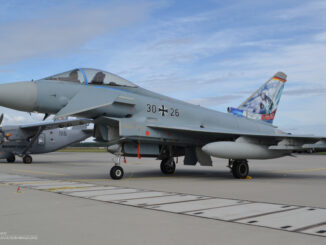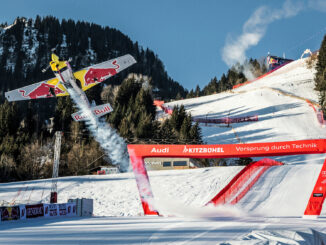 Saab 105Ö (c/n 105426, RF-26 of the Austrian Air Force / Österreichische Luftstreitkräfte) taxiing to apron of Sliač Airport, during the 2015 edition of Slovak International Air Fest, Sliač, August 2015.
Saab 105Ö (c/n 105426, RF-26 of the Austrian Air Force / Österreichische Luftstreitkräfte) taxiing to apron of Sliač Airport, during the 2015 edition of Slovak International Air Fest, Sliač, August 2015.
At the end of 1950s, the Saab company launched its private venture programme to develop a small and inexpensive multi-purpose aircraft, powered by two jet engines and designated Saab 105. The initial idea was to create a turbofan-powered aeroplane that could be offered for various military operators but also as a business jet.
Nowadays, such an idea may seem to be very strange but, at that time, management of the Saab company really thought about the Saab 105 as four- or five-seat business jet. The aircraft had to allow the company to enter into that corporate aeroplane market by offering a small, but cost-effective and modern aeroplane. Regrettably, it quickly turned out that no business customers are interested in the Saab 105 and that put the entire project under threat of abandonment.
However, the new jet gained the interest of the Swedish Air Force (Flygvapnet) authorities. The air force was ready to finance further development of the aircraft and then, if its military aviation expectations are proven, to order a large number for training purposes. The programme officially began at the end of 1961 and on 29th June 1963, prototype of the Saab 105 performed its maiden flight.
Series of evaluation flights confirmed the aeroplane has an appropriate flying characteristic for a trainer, is capable to perform aerobatic manoeuvres and, in addition, can be also used as light-attack aircraft. Therefore, on 6th March 1965, the Government of Sweden approved an order for 130 examples of the Saab 105, in three main configurations – four-seat training jet (officially designated Sk 60A) and two-seat light-attack (Sk 60B) and reconnaissance (Sk 60C). On 17th July 1967, the aircraft was officially introduced into operational service with the Swedish Air Force.
Nowadays, several tens of the Saab 105 jets are still operational with Flygvapnet and used for training and liaison duties. In the 1990s, those aircraft were a subject of upgrade programme that included a change of initial Turbomeca Aubisque engines for modern and more cost-effective Williams FJ44-1. Nevertheless, their days are numbered – in 2021, the Swedish Air Force decided to replace the Saab 105 with Grob G 120TP as the new basic training aircraft.
Although, at the very beginning, the Saab company created that small jet with intention to sell it worldwide, the Saab 105 did not achieve any significant international success. The aircraft was offered to Switzerland (Saab 105H) and Finland (Saab 105S) but eventually lost the bids.
Eventually, Austria became the only country, besides of Sweden, to acquire the Saab 105 jets. The aircraft were purchased at the end of the 1960s and entered service with the Austrian Air Force in July of 1970. The Austrian version, officially designated Saab 105Ö (sometimes written as ´105Oe´), was based on the Saab 105XT, an upgraded demonstrator built from the second prototype and powered by two General Electric J85 engines.
In 2010, one of the Austrian jets – the Saab 105Ö ´RF-26´ – was re-painted into a special ´tiger livery´, celebrating the 40th anniversary of service of the 105Ö fleet with the Austrian Air Force. The aircraft was later a frequent participant of European air shows always attracting attention of visitors there.
On 31st December 2020, the Austrian Air Force officially retired its remaining fleet of the Saab 105, after fifty years of active service.



